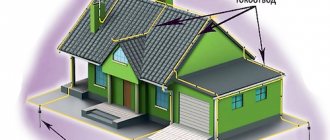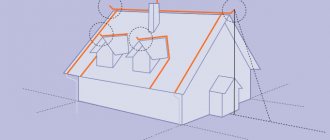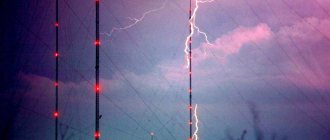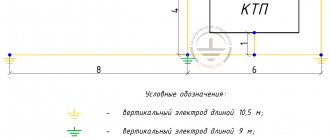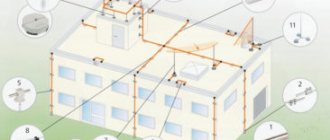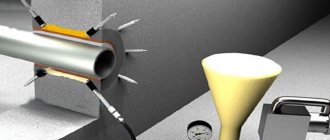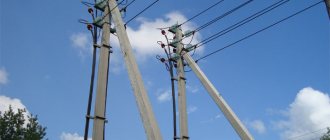Lightning is considered one of the most dangerous natural phenomena. In fact, it is an electric current in concentrated form, formed in air with high humidity and a simultaneous sharp temperature change. The emitted discharges have enormous destructive power and are capable of hitting objects until they are completely destroyed. Quite often, a sharply increasing electrodynamic voltage leads to the explosion of individual structural elements. In this regard, lightning protection of buildings and structures, which includes a whole range of different measures, is of great importance.
The need for lightning protection
Almost everyone knows that lightning protection is necessary, especially owners of private houses. Those who neglect these measures sooner or later expect serious material damage and possible injury from electric current to people living or working at the site.
Most often, lightning strikes lead to the following negative consequences:
- Buildings, structures, utility networks and communications are partially or completely destroyed.
- Electrical appliances and equipment in the affected area fail. Electrical installations are damaged and in many cases they cannot be repaired or restored.
- People and animals who were inside or near an object struck by lightning are injured and killed.
As already noted, any lightning is a powerful electrical discharge that easily destroys most structures. They cause serious damage to power lines, appliances and equipment. Entering the lower layers of the atmosphere, lightning strikes the highest point located in the danger zone. Therefore, a high-quality lightning rod, properly manufactured and installed, is quite capable of protecting objects and people in them from mortal danger and mechanical destruction.
Thunderclouds form against the backdrop of sudden temperature changes and high air humidity. Under these conditions, the atmosphere begins to fill with clouds with negative charges. Electrostatic induction occurs between the thunderstorm front and the surface of the earth, which leads to a discharge according to the principle of a capacitor. Gradually, the electric field strength increases, and tall objects, creating ionization of the air, reduce its resistivity and thereby give an impetus to lightning to strike.
These same physical properties were used when one or another lightning protection system was developed, receiving a strike and discharging high currents into the ground. At the same time, fires, mechanical damage and other negative consequences are completely excluded. Design and installation are carried out on the basis of regulatory documents - PUE, section “Lightning protection of buildings and structures”, SNiP 3.05.06-85, instruction RD 34.21.122-87 and GOST R IEC 62561.2-2014. They also determine the basic requirements for lightning protection.
Features of protecting urban facilities
The lightning protection system for any city structures (including residential apartment buildings) can have a variety of designs. The choice of one or another protective design option is usually determined by the following factors:
- design features of the protected structure itself;
- the presence of electrical equipment located in open and closed spaces of the building, as well as its vulnerability from the point of view of lightning strikes;
- quality of grounding used in the protection system;
- an indicator of thunderstorm activity characteristic of a given area.
In addition, the requirements for lightning protection of such buildings must satisfy current standards, which involve dividing them into different categories from the point of view of protection.
These categories take into account the presence in these buildings and the nature of the storage or processing of explosive and flammable substances. At the same time, category 1 is considered the most dangerous in terms of lightning damage, and category 3 is considered the safest.
An important factor that has a significant impact on the choice of lightning protection for an urban facility is its “surroundings,” which may include high-rise objects (boiler room pipes, local television towers, etc.).
Taking into account all the above factors, lightning protection is organized for typical urban facilities, including apartment buildings and industrial enterprises.
Damaging factors of lightning
In order to fully understand the danger of lightning strikes, it is necessary to become more familiar with its damaging factors. They must be taken into account when designing lightning protection devices for buildings and structures. At the moment of discharge, the overwhelming majority of thunderclouds have a negative polarity, while positive charges are inducted on the ground.
On average, each cloud before the start of the discharge has the following characteristics:
- Near the surface of the earth, the cloud has an electric field strength in the range of 5-300 kV/m.
- The potential ranges from 100 million to 1 billion volts.
- A single discharge of a cloud occurs in the interval from 15x10-6 to 10-3 seconds; a complete discharge requires 1.13 seconds.
- Directly in the lightning channel, a temperature of 20 thousand degrees or more is formed.
- The amplitude current value is 50 kA, in some cases up to 250 kA.
The effect of electrical discharges can be primary or secondary, depending on the damaging factors. They are taken into account when creating a lightning protection system for buildings. The primary damaging factor is a direct lightning strike to a specific object. The main consequences are fires and mechanical damage to buildings and structures.
Secondary damaging factors, of which there are several types, are manifested in the following:
- Electrostatic induction. Induced electrical potentials arise on metal structures isolated from the ground. Their appearance is associated with a high-tension static field between thunderclouds and the ground. As a result, sparking occurs between equipment parts and metal structures.
- Electromagnetic induction. On metal pipes, air ducts and other long elements with open circuits, an emf is induced at the moment of discharge. This phenomenon occurs under the influence of a powerful magnetic field that changes over time. As a consequence, sparking also occurs here in places where metal structures are located as closely as possible.
- High potentials that can enter the building through communications and metal structures located outside the facility. All this must be taken into account during construction at the design stage.
1.1.29
For color and digital designation of individual insulated or non-insulated conductors, colors and numbers must be used in accordance with GOST R 50462 “Identification of conductors by colors or digital designations”.
Protective grounding conductors in all electrical installations, as well as neutral protective conductors in electrical installations with voltages up to 1 kV with a solidly grounded neutral, incl. tires must have the letter designation PE and color designation with alternating longitudinal or transverse stripes of the same width (for tires from 15 to 100 mm) of yellow and green colors.
Zero working (neutral) conductors are designated by the letter N and the color blue. Combined neutral protective and neutral working conductors must have the letter designation PEN and a color designation: blue along the entire length and yellow-green stripes at the ends.
Categories of lightning protection of buildings and structures
According to instructions RD 34.21.122-87 and GOST, all types of buildings and structures are divided into three categories or groups in accordance with the required lightning protection measures. To distribute objects into each of them, there are certain rules, factors, norms and requirements. In addition, a meteorological map is used. First of all, the significance of each structure, its purpose, the presence of flammable and explosive substances, location, frequency of lightning strikes, and others are taken into account.
First category
Includes buildings and structures that require the highest level of protection. These are mainly objects with a high probability of explosions. The main components of protective systems are rod or cable lightning rods installed at a certain distance from each other. Of great importance is the correct calculation of the ground electrode, which can be artificial, made of metal structures, or existing reinforced concrete products are used for these purposes.
Second category
Also contains buildings containing explosive substances. This also includes some types of outdoor technological structures, open-type fuel and lubricant warehouses, rooms with flammable liquids, etc. Buildings of this category must be reliably protected from direct discharges, as well as from the introduction of electric current through overhead and underground communications, or as a result of electromagnetic induction.
The lightning rod for such objects is a metal mesh, the cell pitch of which has certain dimensions. In some cases, depending on specific conditions, rod or cable structures may be installed.
Third category
This group includes buildings located in areas where thunderstorms last more than 20 hours throughout the year. All protective measures are carried out within the 2nd category. They are aimed at protecting against direct hits and the introduction of high potentials from outside.
In some cases, lightning protection of buildings and structures is not required. The only condition is the presence of a roof that can serve as a natural lightning rod. To do this, the thickness of the steel roof must be 4 mm, copper - 5 mm, aluminum 7 mm and above.
Grounding switches
1.7.109. The following can be used as natural grounding electrodes:
1) metal and reinforced concrete structures of buildings and structures that are in contact with the ground, including reinforced concrete foundations of buildings and structures that have protective waterproofing coatings in non-aggressive, slightly aggressive and moderately aggressive environments;
2) metal water pipes laid in the ground;
3) casing pipes of boreholes;
4) metal sheet piles of hydraulic structures, water conduits, embedded parts of valves, etc.;
5) rail tracks of main non-electrified roads and railways and access roads in the presence of a deliberate arrangement of jumpers between the rails;
6) other metal structures of structures located in the ground;
7) metal shells of armored cables laid in the ground. Cable sheaths can serve as the only grounding conductors when there are at least two cables. Aluminum cable sheaths are not allowed to be used as grounding conductors.
1.7.110. It is not allowed to use pipelines of flammable liquids, flammable or explosive gases and mixtures, and sewerage and central heating pipelines as grounding conductors. The specified restrictions do not exclude the need to connect such pipelines to a grounding device for the purpose of equalizing potentials in accordance with 1.7.82.
Reinforced concrete structures of buildings and structures with prestressed reinforcement should not be used as grounding conductors, however, this restriction does not apply to overhead line supports and outdoor switchgear support structures.
The possibility of using natural grounding conductors based on the density of currents flowing through them, the need for welding reinforcing bars of reinforced concrete foundations and structures, welding anchor bolts of steel columns to reinforcing bars of reinforced concrete foundations, as well as the possibility of using foundations in highly aggressive environments must be determined by calculation.
1.7.111. Artificial grounding conductors can be made of black or galvanized steel or copper.
Artificial grounding conductors should not be painted.
The material and smallest dimensions of grounding conductors must correspond to those given in Table 1.7.4.
1.7.112. The cross-section of horizontal grounding conductors for electrical installations with voltages above 1 kV should be selected according to the condition of thermal resistance at a permissible heating temperature of 400 °C (short-term heating corresponding to the duration of the protection and tripping of the circuit breaker).
If there is a risk of corrosion of grounding devices, one of the following measures should be taken:
increase the cross-sections of grounding conductors and grounding conductors, taking into account their estimated service life;
use galvanized or copper grounding conductors and grounding conductors.
In this case, one should take into account the possible increase in the resistance of grounding devices due to corrosion.
Trenches for horizontal grounding conductors must be filled with homogeneous soil that does not contain crushed stone and construction waste.
Grounding electrodes should not be located (used) in places where the ground is dried out by the heat of pipelines, etc.
Active and passive lightning protection
Different types of external lightning protection are a system consisting of conductive structures, some of which are installed in the upper part of objects. They intercept a lightning bolt and then release its high energy into the ground. The effect of such protection depends on the number of components and the coverage density of the hazardous area, and on the architectural features of a particular building. All processes here occur naturally, therefore such standard systems represent passive lightning protection.
Typically, it includes the following components:
- Lightning rod. Attracts to itself and receives electrostatic atmospheric discharge. Structurally, the design options come in the form of metal rods, cables stretched between supports or a receiving mesh with a set cell pitch. The latter option is used mainly on flat roofs with large areas.
- Down conductors. They seem to play a secondary role, but without them it is completely impossible to remove high currents that enter the lightning rod. They are made of thick steel wire with a diameter of 8 mm or more. This cross-section ensures the safe passage of large potentials within a short period of time.
- Grounding and lightning protection. They are used together and consist of individual grounding electrodes or an entire system that combines several electrodes into a single grounding loop. Down conductors can be connected to an existing grounding, but for this you will need to connect special arresters to the circuit.
Parts of the structure
For a more precise understanding of the essence of the requirements, it should be taken into account that a typical lightning protection design consists of the following main parts:
lightning rod mounted at the highest point of the object;- a special tape conductor used as a connector of the discharge receiver with a grounding device (GD);
- the ground electrode itself, which ensures the discharge current flows into the ground.
Thus, each of the constituent elements of lightning protection performs its own, well-defined function that meets the requirements of current regulations, in particular PUE.
Types of lightning rods
In protection systems, natural lightning rods are used as much as possible, based on existing structural elements. If they do not give the desired effect, artificial lightning rods are used, which in most cases play a key role. They are simple to use and do not require special technical equipment. maintenance, but at the same time guarantee reliable passive protection against high current charges caused by lightning strikes.
All lightning rods rules and regulations are conventionally divided into three main types. Rod structures (Fig. 1) are made in the form of a vertical metal mast, with a height of 1 to 20 meters. They are installed directly on the roof or near the building. In the latter case, the protective zone must cover the protected object.
Using clamps, they are fixed to any surface - vertical and horizontal. Each mast is connected to two down conductors, which, in turn, are connected to the ground loop. Rod-type devices protect mainly small buildings with a simple architectural design.
A cable lightning rod (Fig. 2) is a structure that includes two masts and a steel cable stretched between them. The ends of the cable are connected to their down conductors and then to grounding conductors. The correct location of all components ensures that electrical discharges escape into the ground beyond the outer boundaries of the building. Cable devices, just like rod devices, can be single, double or multiple, completely enveloping and protecting the object. A multiple system is installed in large buildings or several structures located over a large area.
To make an air-termination mesh (Fig. 3), metal wire or rod is used. It is laid on the roof surface with a cell pitch from 5x5 m to 20x20 m in accordance with the protection category of the given object. If the roof is made of non-combustible materials, the mesh can be laid directly on it. Otherwise, a distance of at least 10 cm must be maintained.
Fastener clamps may come into contact with walls made of combustible materials if the elevated temperature does not pose any danger to them. Installation of down conductors is carried out along the entire perimeter at a distance of 10-25 meters from each other, in accordance with the level of protection of the building.
ELECTRIC CARS
7.4.15. In fire hazardous areas of any class, electrical machines with voltage classes up to 10 kV can be used, provided that their shells have a degree of protection in accordance with GOST 17494-72* that is not less than that indicated in table. 7.4.1.
In fire hazardous areas of any class, electric machines can be used, blown with clean air with ventilation in a closed or open cycle. When ventilation is in a closed cycle, the ventilation system must have a device to compensate for air losses and create excess pressure in machines and air ducts.
It is allowed to change the degree of protection of the shell against water penetration (2nd digit of the designation) depending on the environmental conditions in which the machines are installed.
Until the electrical industry masters large synchronous machines, direct current machines and static converter units in an enclosure with a degree of protection IP44, it is allowed to use machines and units with a degree of enclosure protection of at least IP20 in fire hazardous areas of class P-IIa.
7.4.16. Air for ventilation of electrical machines must not contain vapors and dust of flammable substances. The release of exhaust air with an open ventilation cycle into a fire hazardous area is not allowed.
Installation of lightning protection down conductors
Any lightning protection will not work normally if there are no down conductors and their correct placement relative to each other. It is through them that the electric current leaves the receiver and, entering the ground electrode, spreads in the ground. There are regulatory documents that determine the number and material of down conductors, their optimal cross-section and distances between lines. All this data is used when drawing up lightning protection projects.
The installed down conductor must meet the following requirements:
- After a lightning strike, the current must flow to the ground in several parallel paths.
- The current flows along the shortest path. The down conductor is installed in a straight vertical position, excluding any loops and sharp turns.
- The distances from down conductors to windows and doors must ensure the required level of safety.
The number of current-carrying lines is determined primarily by the size of the building and the type of its roof. If the perimeter of the object is less than 20 meters, then one down conductor is sufficient. When using several elements, they are distributed evenly along the entire perimeter, starting from any corner.
The simplest lightning protection consists of two down conductors located in parallel and uniformly discharging large currents to the ground. They are laid in a straight line, without bends or sharp corners, to prevent sparks, which pose a serious danger. The total number of lines is calculated for each specific case, the minimum distance is 10 m. The distance from windows and doors must be at least 50 cm.
Requirements SO 153-34.21.122-2003
In addition to issues related to the arrangement of lightning protection at government facilities of any form of ownership, the instructions under this designation discuss the procedure for preparing and storing all accompanying documents.
Documentation
The as-built documentation prepared in this case must include a complete set of calculations, diagrams, drawings and explanatory notes that determine the procedure for installing special equipment within the protected area.
When preparing it, both the location of the building on the general development plan (taking into account the laid communications) and the climatic conditions in the area should be taken into account.
Delivery of the object
In addition, this document establishes the general procedure for the technical acceptance of lightning protection systems, as well as the specifics of their commissioning. It is specifically stipulated that for the acceptance of a building or structure, a special commission is appointed, consisting of representatives of the contractor and the customer, as well as a fire service inspector.
The working commission must be provided with all documents on the lightning protection being installed, including a test report for down conductors and grounding conductors. Members of the commission must familiarize themselves with the results of a visual inspection of all components of lightning protection, as well as with the measures taken to protect the facility from the removal of dangerous potentials and overvoltages.
Based on the results of studying the documentation provided by the developer, acts of acceptance and admission of lightning protection equipment into operation are issued.
After this, special working passports must be issued for each individual device (for the entire system and the ground electrode), which remain with the person responsible for the electrical facilities of the facility.
Examination
In the sections of the instructions relating to the operation of the lightning protection devices put into operation, it is separately stipulated that the procedure for their maintenance and maintenance is determined by the basic provisions of the PUE. At the same time, in order to maintain the systems in working order, annual inspections of all its components must be carried out.
Such surveys are organized before the start of the thunderstorm season, as well as after any changes or improvements are made to the lightning protection design.
Lightning protection grounding device
Grounding loops are located at a distance of at least 1 meter from the object itself, paths and other places where people frequently appear. This requirement allows us to avoid the step voltage that arises during the process of spreading the charge over the ground.
If the facility has a massive reinforced concrete foundation, the grounding should be located even further, and lightning arresters should be installed inside the building to protect electronic equipment. This requirement is mandatory, since part of the lightning charge falls on the foundation and other elements in contact with it - utility networks, equipment housings.
The main indicator of grounding is its resistance. If two separate circuits are used, they are connected to each other by steel conductors by welding. The circuit resistance should be minimal so that the current can easily flow to the ground. If the soil resistivity is 500 Ohms, then the standard resistance of the ground electrode will be 10 Ohms. At higher soil resistances, the following formula is used for calculations: Rз = 10 + 0.0022 (ρ – 500) Ohm, where Rз is the resistance of the ground electrode, ρ is the soil resistivity indicator.
Standard values can be obtained by replacing the soil. The old soil is removed, and soil with other parameters and characteristics is placed in a hole or trench. After this, grounding is installed in the renewed soil. In another case, chemical reagents are added to the soil that can change its performance in the desired direction.
Once the grounding is established, regular measurements of its resistance are subsequently carried out. If its performance is outside the standard range, you should install an additional pin or replace the inappropriate element. Particular attention is paid to the connections between all components of the grounding device.
Application of the TN-C system
This grounding system was and remains the most widespread in the country. With such a system, the transformer neutral is grounded at the substation. The neutral conductor is connected to the grounded neutral at the substation. In this case, the neutral conductor performs the functions of working and protective conductors and is called a PEN conductor.
Electrical installations are powered by two wires for single-phase power or four wires for three-phase power. When using the TN-C system, there is no grounding contact in electrical sockets, and the housings of all industrial electrical appliances and electrical installations in production are grounded.
The disadvantage of the system is the threat of electric shock if the neutral conductor breaks. The advantage is inexpensive electrical installation. According to the rules for electrical installations, the TN-C system was replaced by other, safer systems - TN-S and TN-CS.
Lightning protection from "Aleph-EM" - your safety is in good hands!
will design and install lightning protection for buildings of all types, of any degree of complexity, in a short time and as efficiently as possible. Our specialists will offer each client individual, safest and most economical solutions, with the optimal selection of devices and materials. More than ten years of experience in the field of lightning protection, cooperation with one of the world's leading manufacturers - German, high qualifications and professionalism of our employees allow us to offer our customers durable, reliable protection at the most reasonable prices. In our catalog you will find a wide selection of lightning protection devices of all types.
Lightning protection from Alef-EM is high quality, innovative technologies, durability and reliability. You save time and money, while receiving complete safety; we do our job efficiently, getting another satisfied client.
Technical standards
The list of working documents regulating purely technical issues of lightning protection includes various standards, regulations and amendments, drawn up in the form of a set of special recommendations.
A number of standards included in the regulatory framework and listed in the second section of the article can be taken as a sample of such amendments and special comments.
The last remark concerns building codes and regulations, as well as a number of GOSTs and standards related to the development and operation of modern lightning protection equipment.
In conclusion, it should be noted that all the documents reviewed naturally complement each other, covering a complete list of issues related to the arrangement and maintenance of protection systems against natural electricity discharge.
